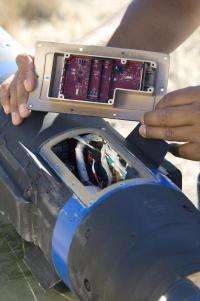Health check for Hellfire missiles: Auto-doc onboard

A new on-board missile health-monitoring device is providing troops in the Middle East an added measure of assurance that the Army's Hellfire II missiles will perform without failure. This marks the Army's first-ever deployment of missiles that features a device to constantly monitor the weapon's battlefield readiness.
The new capability, referred to as the Captive Carry Health Monitoring device, was developed at the Department of Energy's Pacific Northwest National Laboratory in Richland, Wash., under a project led by COL Michael Cavalier, Joint Attack Munition Systems Project Office in Huntsville, Ala.
The Hellfire II missiles, equipped with this advanced data-gathering system, have made their way to Iraq and Afghanistan bases for front-line deployment and use on Apache helicopters. The system recently won the Army's 2009 Acquisition, Logistics, and Technology Continuous Process Improvement Award.
"Missiles featuring this monitoring device are able to maintain a detailed account of important conditions that can negatively affect a weapon's reliability," said Kurt Silvers, Project Manager at PNNL. "Conditions like temperature, vibration, humidity and shock are considered 'health factors', which can degrade a missile's readiness." The system instills confidence in soldiers who rely and depend on the weapons to perform without fail at all times, according to Silvers.
The Captive Carry Health Monitoring device, or the CCHM, automatically monitors and records environmental conditions that can be damaging to a missile's many sensitive internal systems. Data is constantly captured in the CCHM circuitry, which is easily reviewed at routine times by the ground-based personnel. This instant access to vital missile 'health data' allows ground crew and maintenance personnel the information needed when deciding to deploy the weapon to the battlefield. Without the CCHM system, teams have been required to manually track conditions and log the detailed data for each of the hundreds of missiles under their watch.
"These weapons must operate without failure in incredibly harsh conditions," said Michael Adams, CCHM Project Manager at Joint Attack Munition Systems Project Office. "The CCHM monitoring device takes the guess work out of capturing and recording this vital information."
The Army is currently testing and monitoring its first deployment of missiles with CCHM capability for temperature, vibration and length of time the missile is combat-ready aboard an Apache-D helicopter. Following a thorough assessment of this first phase of evaluation, the Army may consider a second testing phase to track other sensor capabilities like shock and humidity.
Provided by Pacific Northwest National Laboratory
















